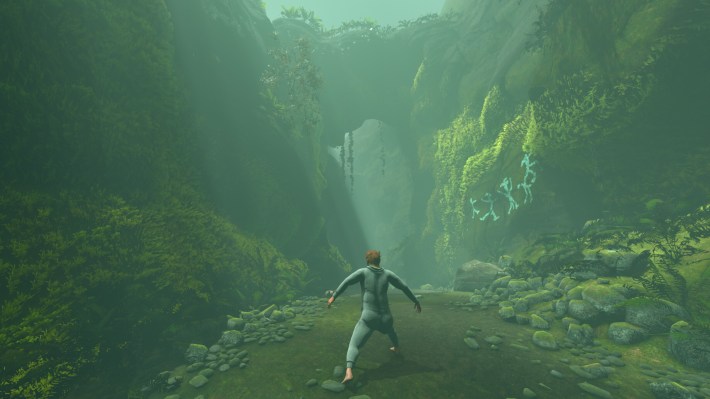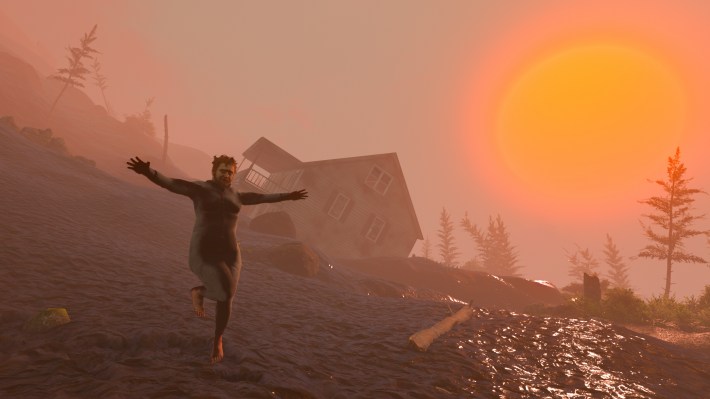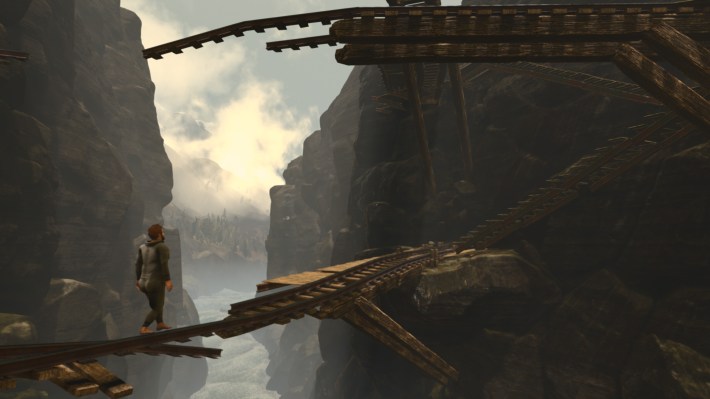Rhythm is important in Baby Steps. If you’re to get Nate—the playable man-child in Gabe Cuzzillo, Maxi Boch, and Bennett Foddy’s latest game—anywhere, you’re going to need to find your rhythm. Fiddling with a controller’s triggers, walking up, around, and through Baby Steps' many obstacles is not easy. But it is possible, and made all the more satisfying by the game’s dynamic sound design that creates music from both nature and the way in which Nate interacts with the world.
Maxi Boch, Baby Steps' sound designer, developer, and designer, told Aftermath it was an “intense undertaking” for her and her team (DJ and producer Ashe Kilbourne and game designer and composer Jack Schesigner).
“The music of Baby Steps is also walking this uncanny divide—it is made entirely of sounds of nature and the player’s interaction with the world, but is sequenced and rhythmic in a truly human way,” she said.
The wind blowing, a phone ringing, and a seagull’s incessant squawking becomes music set to Nate’s muddy footsteps and belabored grunting. In an interview with Aftermath, Boch spoke about her approach to sound design for a game that’s outside the bounds of reality—like creating sounds for Nate falling down a breast milk river.
[Ed. note: This interview has been edited for length and clarity.]

Aftermath: What role does sound design play in creating the world of Baby Steps?
Maxi Boch: The world of Baby Steps is split between intense commitments to reality & fidelity and joyful embrace of the unique unrealities of video games. Sound in games is essential to creating a unique and pleasurable game feel, and I see my job as trying to make everything the player does as juicy and detailed and pleasurable from a low level interaction standpoint, even if that means going for hyper reality, so that the player can find joy in just touching stuff and exploring the world.
To that end, we try to bring a robust materiality to every interaction so that the ground you are walking on, tripping on, or falling over/sliding down. When you swim in Baby Steps, we model the displacement of water and play differential sounds depending on whether your feet break the surface of the water, whether you are displacing water (what we call a “slosh”) or pressing against it (a “splash”). There are 31 unique surface sounds in babysteps, and with each step, we are usually blending between two different surface sounds to arrive at a super-unique sounding step. If your foot scuffs a rock, then slides past some dirt and onto a moss-covered rock, we play a scuff that is tailored to the length of your contact with that rock, then layer in a custom slide sound that fades between dirt and and moss and rock, culminating in that unique step sound blending moss and rock in a way that the player has likely never heard before and will never hear again. The result is that the player doesn’t hear footstep sound effects, instead they start to believe the terrain is real, which makes the extremely tough and purposely difficult challenges feel somehow more fair.
So with every slide down a breast milk river there is a bit of the “ahhh” sound that I make after swallowing something refreshing, and with every step a bit of me gulping, lending a truly surreal sonic experience.
The world of Baby Steps is a magical place where you can survive a fall from any height. But when you fall, we don’t want the kind of visceral, bone-breaking sounds that one might expect from an enormous tumble. Instead, we play up the slapstick nature of the fall with clattering sound effects that are detailed and complex to the point of silliness, bringing a jovial quality to the inevitable failures you’ll encounter in Baby Steps. Likewise with Nate’s yelling—we have a forthcoming feature where when Nate starts yelling he won’t ever stop, like his lungs just have infinite capacity for wailing and whining.
But when you slide down a river of breast milk, what the hell do we do given that commitment to reality? That’s where we roll up our sleeves and try to come up with bizarre sound combinations that would never exist in the real world. So with every slide down a breast milk river there is a bit of the “ahhh” sound that I make after swallowing something refreshing, and with every step a bit of me gulping, lending a truly surreal sonic experience.
None of that would be possible without a super performant low level audio system, because, as a physics game, we also have to be hitch free. So Jack’s work making our audio system super tight and performant, and coming in at a late hour and porting all of the work over to a new frame work, was truly indispensable in achieving this design.

How did you build and implement the dynamic sound system in Baby Steps, something that adjusts to what’s happening in game?
Likewise with nature sounds: the music of Baby Steps is also walking this uncanny divide—it is made entirely of sounds of nature and the player’s interaction with the world, but is sequenced and rhythmic in a truly human way.
Building a system like this is an intense undertaking. We have found that the nature sounds, given that they exist in a space outside of any particular tonal or tempered music (has no scale or key or anything like that), have the unique quality of being able to be broadly interpreted by players according to their play experience and mood.
This allows us to sidestep the emotionally prescriptive feel that scoring can sometimes have, like when the “it’s time to cry” music comes on.
Baby Steps has no particular rules or boundaries enforced, so it’s difficult for us to know when a particular moment is going to be high pressure or emotional for the player—they could’ve decided to climb an almost unclimbable rock and we don’t really have a good way of knowing as much. But players report the birds and animals in the game as either encouraging, or taunting, or celebrating them, depending on their context. This is beautiful to me, and allows us to sidestep the emotionally prescriptive feel that scoring can sometimes have, like when the “it’s time to cry” music comes on.
What's your approach to actually recording the different sounds that make up the sound design?
We are a tiny team and don’t have the resources to do a lot of our own recording with regard to surfaces, wildlife, etc. I have sourced an enormous amount of recordings from a wide variety of pro and independent sources, and worked with Ashe to process them all and get them sounding cohesive. Additionally, we run an enormous amount of analysis to each sound, so that we can understand what tempo is a natural fit for that individual sound, and how that sound compares to the others within the same cue (collection of sounds that come from the same animal, plant, etc.) That way, we can build layouts for our Ableton Live patches where similar sounds are mapped to similar locations on our midi controllers.
This lets us build cool call and response repetition style patterns without actually repeating the same sound over and over again, lending that sense of both reality and impossibility to the memorable animal and bird “hooks” that appear throughout the game and in our trailers. With few exceptions, every animal sound sequenced into songs in the game has been performed by me on an Ableton Push controller, so that it is not robotically gridded and has that looser feel that helps sell the illusion & adds to the groovy musicality.
We transition between intense percussive mixes when you are falling to insect-driven percussion when you’re ambling about
We can also make real-time swaps to other similar sounds if we know the player has heard a particular sound a lot. Our intention is to make the player first question whether there is a music system at all, as if they’re just maybe imaging it, but then they start to realize there is truly a chorus of natural sounds accompanying their gameplay.
We also love intense percussive sound effects, and originally the music design was full of those, but over time we saw the songs messing with the player’s ability to hear their own footsteps. That led us to creating insect mixes of all of the tracks—Ashe headed up that conversion—and now we transition between intense percussive mixes when you are falling to insect-driven percussion when you’re ambling about, which leaves the low end and low mids free for players to be able to hear themselves walk.

What have you learned from your previous works that you brought with you to the sound design of Baby Steps?
Tons! But mostly a sense of how to do it well, and what I’m interested in as a sound designer. My work at Harmonix definitely gave us the production acumen and sense of the value of tools to be able to build something this big and ambitious. Baby Steps does take some things from the learnings of Ape Out, like the value of simplifying complex player inputs to 0-1 ranges to control musical intensity—but is largely oppositional to that sound design’s procedurality, viscerality and violence. Baby Steps has songs with predictable, intentional structure, and we’ll be releasing them in the form of a soundtrack with a list of actual songs.
There are also some traditional musical compositions in the game, but I won’t spoil those for you! I’ll just say that it was wonderful to be able to share the work I have been doing in regard to voice training with the world.


